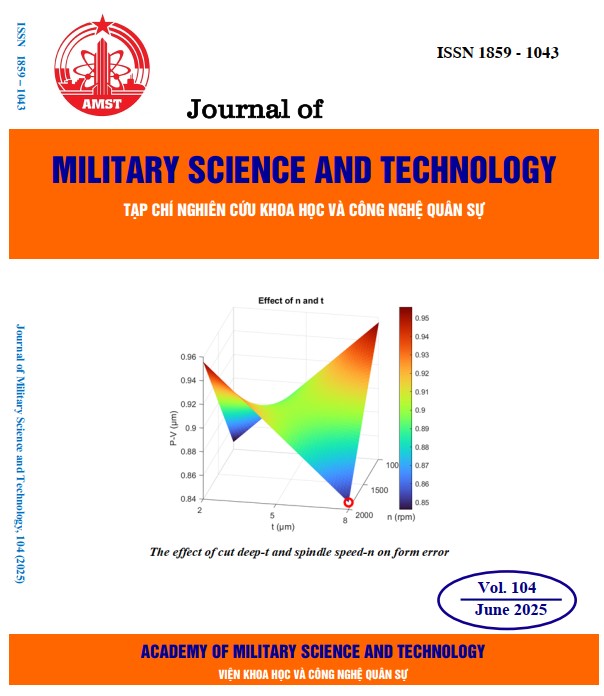Effect of sintering temperature and time on surface hardness of cold-pressed SrFe₁₂O₁₉ pellets: An orthogonal experimental approach
301 viewsDOI:
https://doi.org/10.54939/1859-1043.j.mst.104.2025.182-191Keywords:
Strontium hexaferrite; Cold pressing; Sintering; Surface hardness; X-ray diffraction; Regression analysis.Abstract
This study explores the influence of sintering temperature and time on the surface hardness and microstructure of cold-pressed SrFe₁₂O₁₉ permanent magnet compacts. A two-factor orthogonal experimental design was employed to construct a regression model with high predictive accuracy (R² = 97.23%, AICc = 55.14). Rietveld refinement of X-ray diffraction (XRD) data confirmed the formation of a single-phase of M-type hexagonal structure, with crystallite sizes ranging from 39.5 to 61.8 nm and microstrain values dependent on sintering conditions. The optimal hardness of 93.63 HV was obtained at 1000 °C for 120 minutes, closely matching the model prediction (95.287 HV) with a deviation of only 1.74%. The results demonstrate that controlling sintering parameters is crucial for minimizing microstrain and maximizing hardness, offering practical insights for the processing of high-performance ferrite-based magnetic ceramics.
References
[1]. M. Stingaciu, M. Topole, P. McGuiness, and M. Christensen, “Magnetic properties of ball-milled SrFe12O19 particles consolidated by Spark-Plasma Sintering,” Sci. Rep., vol. 5, pp. 1–8, (2015), doi: 10.1038/srep14112. DOI: https://doi.org/10.1038/srep14112
[2]. Widyastuti, E. Kharismawati, M. Zainuri, and H. Ardhyananta, “Microstructure and magnetic properties of barium hexaferrite produced by sol gel auto combustion for radar absorber material (RAM) application,” Appl. Mech. Mater., vol. 493, pp. 656–660, (2014), doi: 10.4028/www.scientific.net/AMM.493.656. DOI: https://doi.org/10.4028/www.scientific.net/AMM.493.656
[3]. M. Stingaciu, A. Z. Eikeland, F. H. Gjørup, S. Deledda, and M. Christensen, “Optimization of magnetic properties in fast consolidated SrFe12O19 nanocrystallites,” RSC Adv., vol. 9, no. 23, pp. 12968–12976, (2019), doi: 10.1039/c9ra02440a.
[4]. K. V. Suresh, P. Fernandes, and K. Raju, “Investigation on performance and emission characteristics of diesel engine with cardanol based hybrid bio-diesel blends,” Mater. Today Proc., vol. 35, no. xxxx, pp. 378–382, (2019), doi: 10.1016/j.matpr.2020.02.691. DOI: https://doi.org/10.1016/j.matpr.2020.02.691
[5]. E. Urogiova, I. Hudec, D. Bellusova, and Bratislava, “Magnetic and Mechanical Properties of Strontium Ferrite – Rubber Composites,” Test. Meas., no. 5, pp. 224–228, (2006).
[6]. Y. C. Wong, J. Wang, and G. B. Teh, “Structural and magnetic studies of SrFe12O19 by sol-gel method,” Procedia Eng., vol. 76, pp. 45–52, (2014), doi: 10.1016/j.proeng.2013.09.246. DOI: https://doi.org/10.1016/j.proeng.2013.09.246
[7]. A. U. Rashid, P. Southern, J. A. Darr, S. Awan, and S. Manzoor, “Strontium hexaferrite (SrFe12O19) based composites for hyperthermia applications,” J. Magn. Magn. Mater., vol.344, pp. 134–139, (2013), doi: 10.1016/j.jmmm.2013.05.048. DOI: https://doi.org/10.1016/j.jmmm.2013.05.048
[8]. T. T. V. Nga, N. P. Duong, T. T. Loan, and T. D. Hien, “Key step in the synthesis of ultrafine strontium ferrite powders (SrFe12O19) by sol-gel method,” J. Alloys Compd., vol.610, pp. 630–634, (2014), doi: 10.1016/j.jallcom.2014.04.193. DOI: https://doi.org/10.1016/j.jallcom.2014.04.193
[9]. A. Wahi, N. Muhamad, A. B. Sulong, and R. N. Ahmad, “Effect of sintering temperature on density, hardness and strength of MIM Co30Cr6Mo biomedical alloy,” Funtai Oyobi Fummatsu Yakin/Journal Japan Soc. Powder Powder Metall., vol. 63, no. 7, pp. 434–437, (2016), doi: 10.2497/jjspm.63.434. DOI: https://doi.org/10.2497/jjspm.63.434
[10]. M. Aftab, A. Aftab, M. Z. Butt, D. Ali, F. Bashir, and S. S. Iqbal, “Surface hardness of pristine and laser-treated zinc as a function of indentation load and its correlation with crystallite size valued by Williamson-Hall analysis, size-strain plot, Halder-Wagner and Wagner-Aqua models,” Mater. Chem. Phys., vol. 295, p. 127117, (2023), doi: 10.1016/j.matchemphys.2022.127117. DOI: https://doi.org/10.1016/j.matchemphys.2022.127117
[11]. K. R. Sriraman, S. Ganesh Sundara Raman, and S. K. Seshadri, “Influence of crystallite size on the hardness and fatigue life of steel samples coated with electrodeposited nanocrystalline Ni-W alloys,” Mater. Lett., vol. 61, no. 3, pp. 715–718, (2007), doi: 10.1016/j.matlet.2006.05.049. DOI: https://doi.org/10.1016/j.matlet.2006.05.049
[12]. T. T. Viet Nga and N. T. Lan, “Fabrication and exchange-spring properties of SrFe12O19@Fe3O4 nanocomposites with core-shell structure,” Mater. Chem. Phys., vol.251, p. 123084, (2020), doi: 10.1016/j.matchemphys.2020.123084. DOI: https://doi.org/10.1016/j.matchemphys.2020.123084
[13]. Marian Stingaciu et al., “Optimization of magnetix properties in fast consolidated SrFe12O19 nanocrystallites,” RSC Adv., vol. 9, pp. 12968-12976, (2019), doi: 10.1039/c9ra02440a DOI: https://doi.org/10.1039/C9RA02440A
[14]. N. Kumar et al., “Optimization of Sintering Process Parameters by Taguchi Method for Developing Al-CNT-Reinforced Powder Composites,” Crystals, vol. 44, no. 9, pp. 5924–5933, (2023), doi: 10.1002/pc.27537. DOI: https://doi.org/10.3390/cryst13091352







